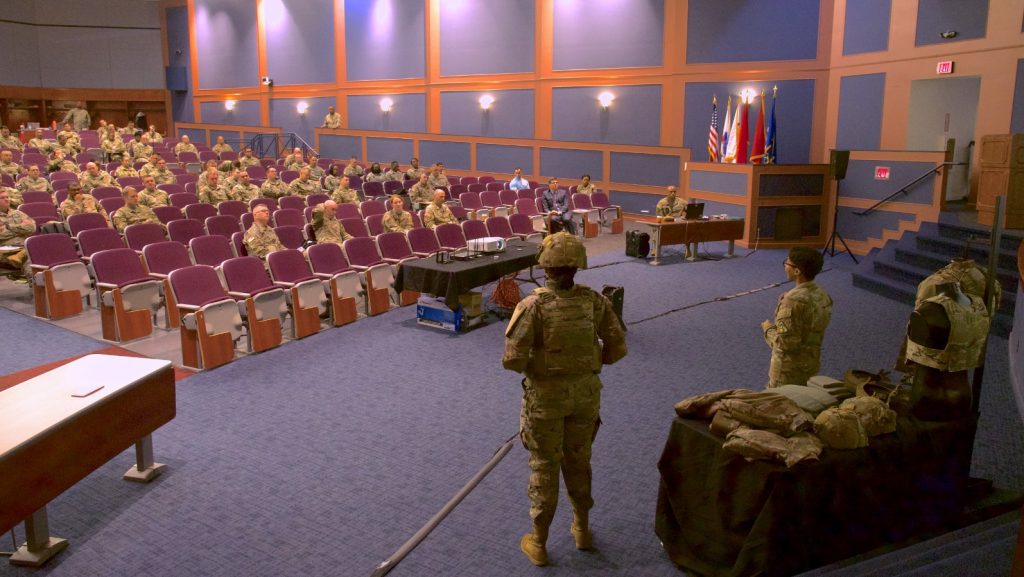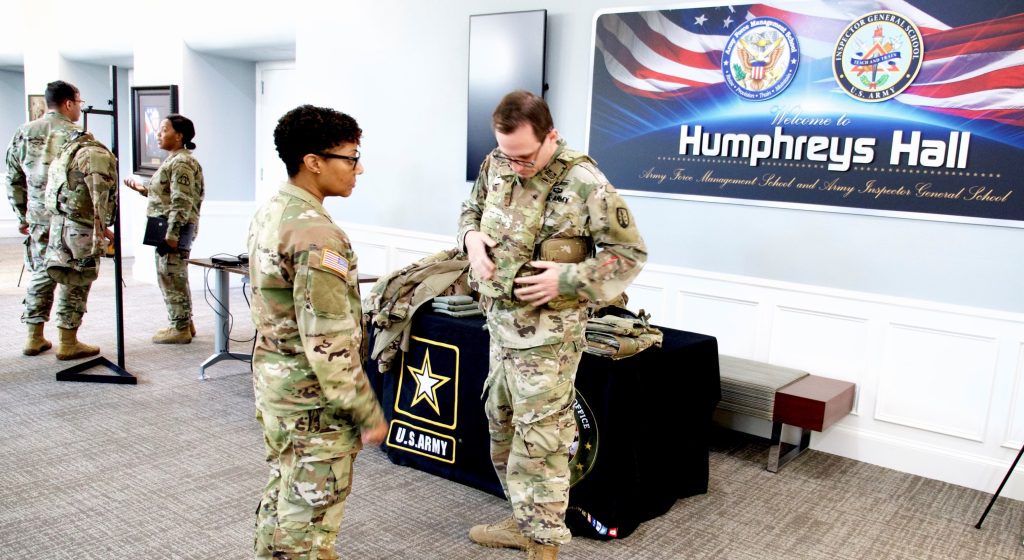
MOVING FORWARD: Maj. Gen. Faulk, commander of the 99th Readiness Division and the Army Reserve senior proponent advisor for acquisition, talks to a Soldier during the question-and-answer session of the Acquisition Training Summit on August 19 at Ft. Belvoir, Virginia. (Photos by Staff. Sgt. Christopher Tobey, 356th Broadcast Operations Detachment, U.S. Army Reserve)
Guard and Reserve acquisition Soldiers return to in-person training to begin a new, Back-to-Basics era.
by Spc. Antonio C. Rodriguez
More than 200 Army Reserve and National Guard Soldiers from acquisition units across the United States and from forward-deployed locations attended the hybrid 2022 Reserve Component Acquisition Training Summit, Aug. 19 through 21. It was the first time in three years that this annual training event was conducted in person as a result of the COVID-19 pandemic. Over 130 Reserve and Guard Soldiers attended the event and more than 60 participated virtually.
Participants received career-enhancing training covering a wide variety of acquisition related topics including educational and credentialing policy, project management and branch-specific modernization plans. The mass training event was intended to ensure that best practices and resources are shared across the acquisition career field.
“Acquisition Soldiers work behind the scenes developing the next capability of the warfighter,” said guest speaker Scott Greene, chief of the Strategies and Communications Division for the U.S. Army Acquisition Support Center at Fort Belvoir, Virginia, where the annual summit takes place. “Opportunities like this summit bring Soldiers together to figure out how they can enable that warfighter.”
Greene, who briefed about acquisition credentialing under Back-to-Basics, informed Soldiers about the changes going on in the defense acquisitions’ framework. New Defense Acquisition Workforce Improvement Act certification standards took effect February 1, where certification levels have been simplified and are more closely tied to position requirements versus employee grade.
“Acquisition certification training is really moving to life-long learning and elective learning,” Greene said. “The responsibility relies more on the individual, as well as their supervisors, to know specifically what [courses] they need to take to get certified.”

MODERN ARMOR : Capt. Kim Pierre-Zamora, right, a reservist attached to the Program Executive Office for Soldier briefs prototypes of next generation body armor during the 2022 Reserve Component Acquisition Training Summit held in August at Ft. Belvoir, Virginia.
BACK TO BASICS
While the overall objective of Army acquisition hasn’t changed, the need to modernize the career field and the systems was a theme throughout the conference.
“In the Army Reserve, we only have 300 acquisition Soldiers [enlisted and officer],” said Col. Keith G. Harley, acquisition advisor to the chief of the Army Reserve and the director of the Acquisition Integration Office. “It’s a small community … Bringing them all together in one place is very vital to their career development.”
Acquisition professionals (51A and 51C military occupational specialties, acquisition career field) support virtually every part of the Army. “From cutting the grass to feeding the Soldier, to developing the weapon systems for the warfighter, it falls under the acquisition umbrella,” Harley said. “We may not be boots-on-the-ground lethality … but everything the Soldier wears or uses, acquisition is touching it first.”
MODERNIZATION FOR 2035
Acquisition Soldiers are involved in the entire modernization process from product and contract development, awarding the contract and fielding the equipment to the Soldiers. This positions acquisition professionals in a particularly vital role for the 2035 Army Modernization Strategy. “Acquisition Soldiers are helping to define what the requirements are—what do those weapons systems look like, where are those weapons systems going,” Harley said. “Start to finish, and cradle to grave.”
Some of the systems associated with the Army’s modernization strategy that were showcased at the summit included the new Modular Scalable Vest, Ballistic Combat Shirt and the Blast Pelvic Protector. “We are scaling back the amount of weight we’re putting on the Soldier,” said Capt. Kim Pierre-Zamora, a reservist attached to Product Manager Soldier Protective Equipment at the Program Executive Office for Soldier. “We’re also giving them that same or increased level of protection.”
Pierre-Zamora presented prototypes of the next generation of body armor and outlined the improvements of the new systems. She described how previous versions of body armor often limited the Soldier’s movement and made it harder for them to perform their combat roles. “Essentially we made the Soldier a turtle with the [Improved Outer Tactical Vest] IOTV and the [Interceptor Multi-Threat Body Armor System] IBA,” Pierre-Zamora joked. “We covered them so much it caused a lot of musculoskeletal issues.” Those issues often lead to Soldiers not wearing their body armor properly or sometimes not even wearing it at all.
The Modular Scalable Vest (MSV) can be more quickly and precisely adjusted to fit Soldiers better than the IOTV. The shoulders of the new vest provide unrestricted arm movement while still protecting the Soldier from shrapnel. The Blast Pelvic Protector is easier to connect, disconnect and store out of the way. “It’s that purpose-driven design,” said Pierre-Zamorra. “We’re trying to make sure our protective equipment works with the Soldiers instead of against them.”
One unique feature of the new body armor is that it allows the Army to repurpose some of the soft armor from the previous versions. “When we’re looking at new equipment, we’re making sure that it works for Soldiers and the Army’s budget,” said Pierre-Zamora. There are many as-yet unused legacy soft armor ballistics in Army storage centers across the country. “We’re cutting down the unused and test-ready soft armor from specific legacy IOTV into the MSV shape that will fit in the new MSV shell,” Pierre-Zamora said. “When we reuse equipment that has not been used and does not ballistically degrade, we are saving the Army millions of dollars.”

LIGHTER AND STRONGER: Capt. Kim Pierre-Zamora, left, watches a Soldier try on a Modular Scalable Vest following her briefing on next generation body armor at the 2022 Reserve Component Acquisition Training Summit held in August at Ft. Belvoir, Virginia.CONCLUSION
In addition to ensuring that current best practices and resources are shared across the acquisition career field, as the Army transforms and modernizes, “One of the things about the Acquisition Training Summit that is so valuable to the acquisition Soldier is networking,” said Harley. “Networking with peers, networking with senior leaders … that linkage is just critical.”
“We only do this once a year,” said Maj. Gen. Rod Faulk, commander of the 99th Readiness Division and the Army Reserve senior proponent advisor for acquisition. “It’s a great opportunity for professionals to network and share their best practices. Also, to enhance their knowledge base in what resources are available and what techniques are successful.” Faulk led one of the key sessions on the first day of the conference introducing the summit and outlining expectations for the Reserve component workforce. He advised Reserve Soldiers to think big and keep improving every day.
“One of the things we talked about was leaning forward and taking new challenges,” said Faulk. “Not sitting back and being comfortable in the job that you’re in today. Do the very best you can with your present job, be a good teammate and you’ll be in demand because you’re always giving your best effort.” He encouraged acquisition Soldiers to use their training to acquire what they need to be successful on the battlefield. If the Army is going to be able to meet its mission in the new multi-domain environment, Faulk said, “We need these folks to be 1000 percent on target!”
He continued, “Our motto in the Reserve is ‘Ready Now, Shaping Tomorrow,’—we have to be ready now. At the same time, we have to evolve our concept of warfare and make sure that we’re able to meet future foes on a future battlefield and dominate.”
For more information contact Col. Keith G. Harley, Office of the Chief of Army Reserve, Director Acquisition Integration Office, keith.g.harley.mil@army.mil.
SPC. ANTONIO C. RODRIGUEZ, from Dallas, Texas, is assigned to the 356th Broadcast Operations Detachment. He joined the Army Reserve in 2017 as a mechanic. He re-enlisted and completed the Defense Information School in March as a 46S military occupational specialty public affairs specialist.


